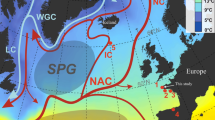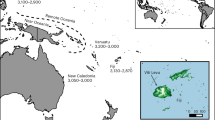Abstract
Changes in the conditions in the ‘warm pool’ in the Pacific region are reflected in the changes in the local climate system of the Philippines. Both El Niño and La Niña episodes in the Pacific Oceans introduce high variability into the local climate pattern, especially rainfall, in the Philippines. Whereas El Niño appears when annual rainfall is ≥10% lower than normal annual rainfall, La Niña occurs when annual rainfall is at least equal to the normal. About 15.7 million ha of forest cover had been lost between 1903 and 1998, but only 1.64 million had been reforested in the same period, indicating the presence of unbelievably low ecological stability. Apart from this, the denuded forests freed about 8.24 × 109 Mg C into the atmospheric greenhouse pools. Neither deforestation nor reforestation was undertaken with deliberate regard to the occurrences of El Niño or La Niña. Very high rates of deforestation were observed to coincide with or precede strong El Niño or Nina episodes, thus confounding further the ecological instability of denuded forest systems, especially those with slope $18%. Similarly, the reforestation cycle indicates that saplings are at most 5 years old every time an El Niño or a La Niña occurs; in most reforestation schemes, saplings are only 1–2 years old when these events occur. These reforested areas are vulnerable to drought in El Niño years and to high runoff erosion during La Niña years. Because they are young, saplings in reforested areas dry easily and pose hazards to forest fires, which were observed to destroy larger tracts of forest cover during El Niño more so when annual rain $10% below the normal. In retrospect, the study indicated that had forests been exploited with conscious regard to the recurrence of El Niño or La Nina episodes, ecological impacts could at least be toned down. In the same vein, reforestation should have been more successful it were implemented with due considerations to extreme climate variability. Once trees were planted, the weather elements become more crucial than politicians’ meddling and other socio-economic factors to the growth and development of reforested sites.
Access this chapter
Tax calculation will be finalised at checkout
Purchases are for personal use only
Preview
Unable to display preview. Download preview PDF.
Similar content being viewed by others
References
ACIAR (Australian Center for International Agricultural Research): 2000, `Bringing trees back in the Philippines’, Research Notes 24(12/00) page 3.
Bengawan, M.A.: 1999, ‘Illegal logging wipes out Philippine forests’, Environment News Service.http://www.ens-news.com/ens/oct1999/1999–10–11–01.asp
Bengawan, M.A.: 2001, M.A.: 2001, ‘Weak laws in the Philippines exacerbate deforestation’, The Earth Times, 23 February 2001.
DENR (Department of Environment and Natural Resources): 1998, Philippine Forestry Statistics, Quezon City, Philippines, Forest Management Bureau.
FAO (Food and Agriculture Organization of the United Nations): 1999, FAOSTAT. Rome, Italy, FAO. http://www.fao.org
IRI (International Research Institute for Climate Prediction): 2002a, El Nino and La Nina years for Atlantic hurricanes. http://iri.columbia.edu/climate/ENSO/globalimpact/TC/Atlantic/ensoyear.htm
IRI.: 2002b, Cold and warm episodes by season. http://www.cpc.ncep.noaa.gov/products
Japan Meteorological Agency.: 1991, COAPS SST 1868–1997. Marine Department Report. http://www.coaps.fsu.edu/pub/JMA_SST_Index.
Jose, A.M.: 2002, ‘ENSO Impacts in the Philippines’, Resources for Impacts and Responses.http://www.unu.edu/env/govern/ElNIno/CountryReports/inside/philippines/TELECONNECTIONS/TELECONNECTIONS _txt.html
Lasco, R.D.: 2001, ‘Carbon stocks of forest ecosystems in Southeast Asia following deforestation and conversion’, APN (Asia-Pacific Network for Global Change Research) Newsletter VII(4) 3–4. http://www.apn.gr.jp/pub027.htm#APN%o20Newsletter%20Vol.7,%20No.4%200ctober%202001
Livezey, R.E.: 1998, Personal communication (by Schaefer et al., 1999).
NSO (National Statistics Office): 2000, Philippine Statistical Yearbook 2000, Quezon City, Philippines, NSO.
Null, J.: 2002, El Nino and La Nina Years: A Consensus List.http://ggweather.com/enso/years.htm
PCARRD (Philippine Council for Agricultural Resources Research and Development): 2001, El Nino Southern Oscillation: Mitigating Measures, Los Banos, Philippines, PCARRD.
Schaefer, J.T. and Tatom, F.B.: 1999, The Relationship Between El Nino, La Nina, and United States Tornado Activity.http://www.spc.noaa.gov/publications/schaefer/el_Nino.htm
StatSoft.: 1998, Statistica v5. 5. StatSoft Inc., OK, USA.
The Xinhua News Agency: 1992, ‘Roundup: Severe drought ravages Philippines’, 18 March 1992.
Author information
Authors and Affiliations
Corresponding author
Editor information
Editors and Affiliations
Rights and permissions
Copyright information
© 2004 Springer Science+Business Media Dordrecht
About this chapter
Cite this chapter
Moya, T.B., Malayang, B.S. (2004). Climate Variability and Deforestation-Reforestation Dynamics in the Philippines. In: Wassmann, R., Vlek, P.L.G. (eds) Tropical Agriculture in Transition — Opportunities for Mitigating Greenhouse Gas Emissions?. Springer, Dordrecht. https://doi.org/10.1007/978-94-017-3604-6_14
Download citation
DOI: https://doi.org/10.1007/978-94-017-3604-6_14
Publisher Name: Springer, Dordrecht
Print ISBN: 978-90-481-6341-0
Online ISBN: 978-94-017-3604-6
eBook Packages: Springer Book Archive




